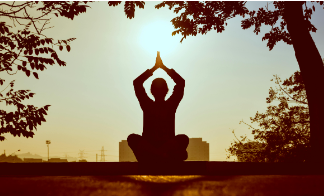Power yoga is a newer version of yoga. It focuses on strength and faster movements. This type of yoga is more active and suits people who want to boost their fitness. Traditional yoga is an old practice that includes physical poses, breathing, and meditation. It helps improve health, flexibility, and mental peace. Traditional yoga mainly focuses on relaxation and mindfulness. Both styles come from the same yoga philosophy but serve different purposes. In this article, we will explore what power yoga and traditional yoga are and how they differ.
Power yoga is an active form that focuses on strength and endurance. It comes from Ashtanga yoga, but it is more inflexible than that because you can make more flow of poses in power yoga. It is a high-energy workout.
In power yoga, you must move quickly between poses that work on different muscle groups while matching movements to breaths. In it, you give your body different challenges while calming the mind and creating a meditative effect. This raises the heart rate and helps burn calories. Also, it helps in improving muscle tone and flexibility. In short, power yoga is a great option for those looking for a full-body workout and mental benefits in one session.

Traditional yoga is an ancient practice from India that connects the body, mind, and spirit. Its main goal is to achieve inner peace and spiritual growth. Unlike power yoga, which focuses mostly on physical poses, traditional yoga includes meditation, breathing exercises (pranayama), and moral values.
One of its key aspects is the Eight Limbs of Yoga by Patanjali. These include ethical rules (yama and niyama), poses (asana), breath control (pranayama), sensory withdrawal (pratyahara), focus (dharana), meditation (dhyana), and spiritual connection (samadhi). This helps people to build good morals, mental clarity, and spiritual depth.
Aspect | Power Yoga | Traditional Yoga |
Pace of Practice | Fast-paced and dynamic | Slower and more deliberate |
Focus | Physical fitness and strength | Mental clarity and relaxation |
Sequence of Poses | Varies with creative flows and quick moves | Specific sequences focus on proper alignment |
Intensity | High-intensity, full-body workout | Moderate intensity |
Breath Control | Present but less emphasized | Strong focus on breathing techniques |
End Goals | Build strength, stamina, and fitness | Gain mental peace, self-awareness, and spiritual growth |
Target Audience | Best for fitness seekers | Perfect for relaxation and mindfulness seekers |
Power yoga has many benefits, especially regarding physical fitness and muscle building. One of the main advantages is increased muscle strength. Many power yoga poses require practitioners to support their body weight, which effectively builds and tones muscles without needing external weight. Additionally, you have to hold the same pose for extended periods, which increases endurance and allows the muscles to develop over time.
Another benefit is improved cardiovascular fitness. Its fast-paced nature of power yoga increases the heart rate and helps in better circulation and overall heart health. This cardiovascular workout helps control blood pressure and cholesterol levels while also helping in weight loss.
Moreover, power yoga increases flexibility and balance through dynamic movements that stretch various muscle groups. This helps a more toned physique and supports overall athletic performance and daily functional activities.
Traditional yoga has many benefits, especially in relaxing your mind and maintaining mental calmness. One of the primary advantages is its ability to reduce stress and anxiety. Through physical postures, controlled breathing, and meditation, traditional yoga gives you relaxation and mindfulness. This stimulates the release of stress-reducing hormones and uplifts your mood and emotional stability.
Regular practice can improve physical flexibility and balance, improving overall physical health. Through traditional yoga, you can focus on your breath and body sensations.

When deciding between traditional and power yoga, it is important to know which will work best for you.
Power Yoga is great for people who want a strong workout that builds strength and improves fitness. Its perfect for those with some fitness experience who enjoy fast and active movements. Athletes and fitness lovers often choose power yoga because it helps build muscle and stamina while offering a tough workout.
Note: Beginners should be careful, as power yoga needs a basic understanding of poses and good physical fitness.
Traditional yoga, on the other hand, is better for those who want a calm and relaxing practice. It reduces stress, improves flexibility, and finds mental peace. This style works well for all levels, especially beginners, as it focuses on slow movements and mindfulness. People interested in spiritual growth or overall well-being may prefer traditional yoga.
Power yoga can work for beginners, but there are some things to consider. It is a lively and energetic practice that helps build strength, improve flexibility, and boost overall fitness. Many beginner-friendly classes focus on basic poses and movements at a slower pace, making it easier for newcomers to try yoga.
However, beginners should know that power yoga can be challenging. Taking it slow is important, especially if you're not used to regular exercise. You can start with beginner classes or videos to help you learn the basics, including proper poses and breathing techniques.
Yes, traditional yoga can greatly support fitness goals. Traditional yoga poses (asanas) stretch and strengthen muscles. It also increases your range of motion and lowers the risk of injuries during other activities. It mainly helps with mental calmness and relaxation, so you feel fresh and do other activities better.
Conclusion
Power and traditional yoga serve different purposes but contribute to overall well-being. Power yoga is suited for those seeking an intense workout that strengthens the body, increases stamina, and improves cardiovascular health through quick, energetic movements. On the other hand, traditional yoga focuses on relaxation, mental clarity, and flexibility, with a slower pace and an emphasis on mindfulness and breath control. Start your yoga journey today and find the practice that suits your needs!









